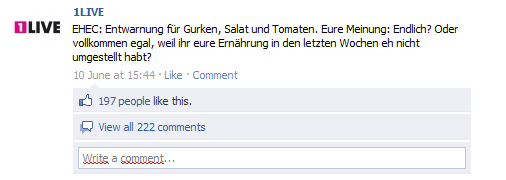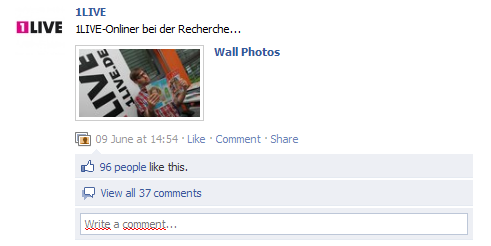7 tips on creating an effective Facebook link
For many, Facebook has changed the face of the media landscape for good. Along with other social networking sites, it’s an important way for news consumers to filter updates from their favorite sources or on events of particular interest to them. It’s also how they share stories amongst their circles of friends.
In turn Facebook and other social media platforms have become key distribution channels for news websites. So it’s all the more important for online news sources to effectively market their content to social media outlets.
German blogger Claus Hesseling has compiled some useful tips for journalists who want to make the most of that potentially added exposure. With his kind permission, you can read a translation of his summary below.

Kirkland House, Harvard University – The birthplace of Facebook. Photo courtesy of rorycellan at Flickr, CC license.
Why link to Facebook
According to Web guru Jeff Jarvis, we live in a link economy. The more you can get others to link to your content, the better off you’ll be. Up until now, Google was the main way to drive Internet users to news platforms. That’s changing rapidly.
Facebook is gaining ground. According to the company, the average media organization saw a 300% increase in Facebook referrals in 2010. For many people it’s the prime – in some cases the only – social networking site they use with frequency. There are even those who check in even before getting out of bed in the morning. People no longer go looking for news, but instead expect the news to come to them.
There’s an upside for online news platforms. Facebook referrals come recommended by friends or because viewers have previously clicked a media organization’s Like button, ensuring that they receive regular status updates in their news feed. That means people are apparently more likely to actually navigate to the news site and read the articles there.
Tips from the horse’s mouth
So after you’ve put all that time and effort into creating a report, it’s a good idea to make the most of a good Facebook link and header. Vadim Lavrusik, Facebook’s journalist program manager, has plenty of very practical tips. Here’s a sampling:
1. Mini vs. micro – make use of all 420 characters!
A status update on Facebook can be up to 420 characters long. Take advantage of that. Whereas on Twitter only a brief headline is possible (microblogging), Facebook provides enough space to say more (mini-blogging). Two to three sentences aren’t a problem – nor a bad idea according to Lavrusik. Here’s an example posted by New York Times reporter Nicholas Kristof:
2. Link to stories that will interest your friends
Only link to the interesting stories! That may sound simple enough, but in practice it’s not so easy. The average news site produces 20 – 50 reports every day. Choosing what to share can be difficult. Andy Carvin, senior product manager for online communities at U.S. public radio network NPR, recommends that editors ask themselves which stories their friends would share and want to talk about on Facebook.
3. Information is good, emotions are key
Stories that touch people emotionally generate engagement. “We share stories that are emotional triggers, that are not just informational,” says Ryan Osborn, director of social media at NBC News. According to Facebook’s Lavrusik, emotional stories and provocative, passionate debates are likely to generate 2-3 times as many clicks as other kinds of post updates. Here’s an example from NBC Dateline:
Sometimes very ordinary occasions that affect many people collectively can trigger a storm of response – like when a German regional radio station posted that it was “soaking wet”:
4. Ask users for their opinion
One of the great things about Facebook is the ease with which readers can contribute their reaction. Clicking the Like button takes virtually no time or effort. It’s equally convenient to write a quick comment – even more so when the person posting invites fans to share their opinion. Encouraging interaction works almost every time when used with care and in moderation. In this example, German radio station 1LIVE invited people to discuss the consequences when health authorities gave the all-clear for certain vegetables after an EHEC scare in Germany. “Your take: Finally? Or does it leave you as cold as a cucumber because you haven’t changed your diet over the past couple of weeks anyway?”
In another example, a German TV news program asked for people’s opinions about Chancellor Merkel’s stance in the Euro crisis after featuring an interview on the topic with a network correspondent:
In these cases too, questions that trigger emotional responses have big impact:
The same goes for questions that pertain to readers’ first-hand experiences:
Opinions differ on the best way to pose questions. Lavrusik of Facebook prefers simple, easy-to-understand formulations whereas NPR’s Carvin says that in his experience, clever, intelligent questions work best. Perhaps, however, that has something to do with the above-average education level of NPR’s target group.
5. Personalize your posts and give people a look behind the scenes
Personalization can create stronger identification with the medium when the person posting is sufficiently well-known. Lavrusik names New York Times’ reporter Nicholas Kristof as a prime example. Kristof gives brief, personalized impressions of his work, usually with an invitation to interact – or as in this case – with a small multimedia bonus:
Nowadays, people’s perception of reality is generated mostly by mass media. Consumers know that of course, so they’re also particularly keen to get a glimpse behind the scenes. An occasional insider’s look can’t hurt, like in this 1LIVE example which shows an online editor at work:
6. Refine your link
For a long time, many news sites automatically channeled all new items to Facebook through an RSS feed. Of course that saves time. But the author, reporter or correspondent put a lot of effort into perfecting his or her article, and all that work can get lost amidst the noise of Facebook. The point shouldn’t be to post to Facebook quickly before the next report arrives. Just like with the teaser and title, some attention should be paid to detail.
When posting a link on Facebook, you can rework the title, gray teaser and commentary text. You can also select a teaser photo from the images featured in the article. Links that incorporate photos usually generate more clicks:
7. Five to ten links per day are enough
As mentioned previously, news desks often post 20-50 items per day. How many of those ought to be linked? Here’s the frequency of some bigger news organizations:
· NBC: 5
· Time: 6-8
· NPR: 8-10 (in intervals of at least one hour)
· New York Times: 1-15
There’s a fine line between drawing people’s attention to your own organization’s news stories on the one hand and raising suspicions of spam by cluttering users’ news feeds full. Five to ten carefully selected links are generally a good rule of thumb.
What’s your experience? If you have more tips and ideas, feel free to leave a comment below.
This post originally appeared in German at netzprotokolle by freelance journalist and journalism trainer Claus Hesseling, who in turn cites cyberjournalist.net. Thanks to Claus for allowing us to adapt and publish the German summary.
Translation: Deborah Friedman















Feedback